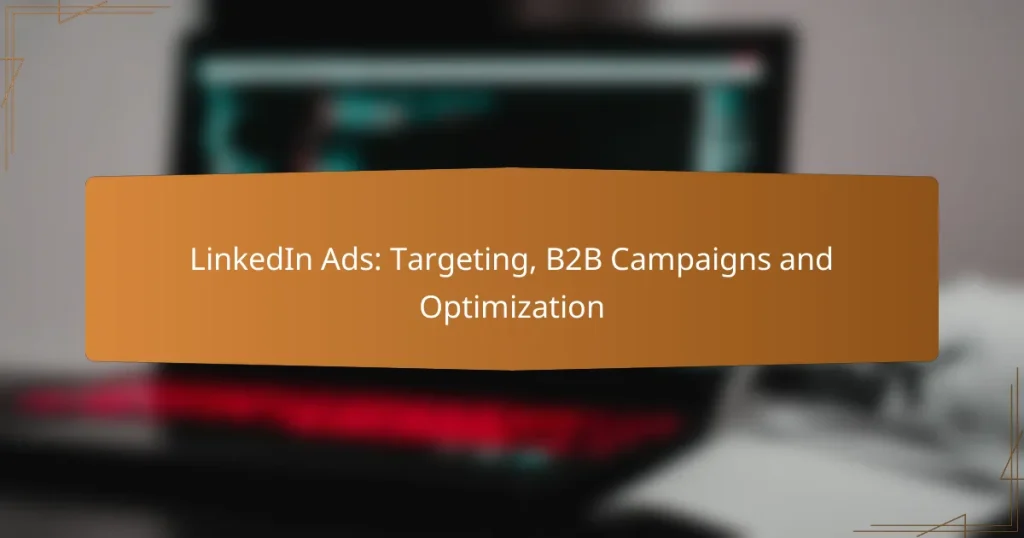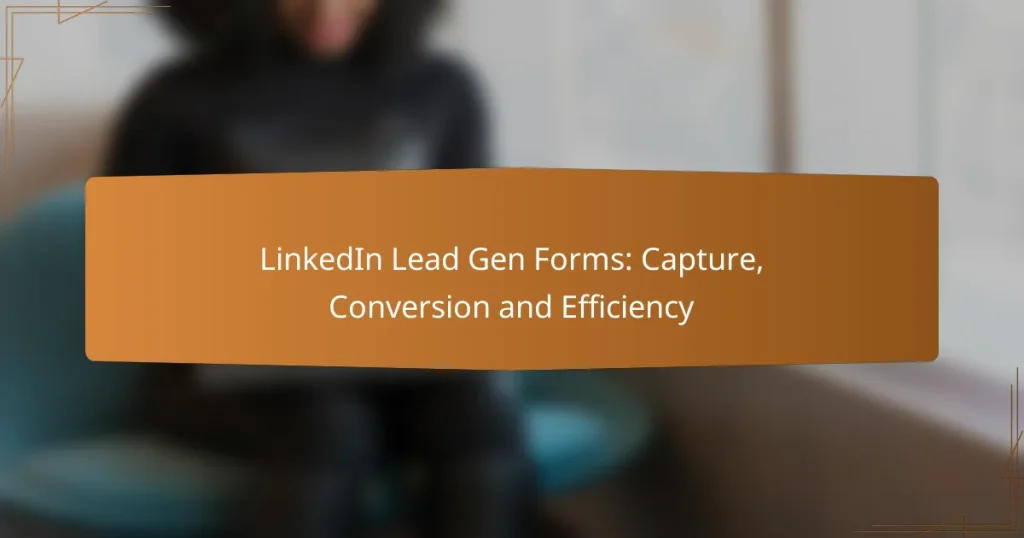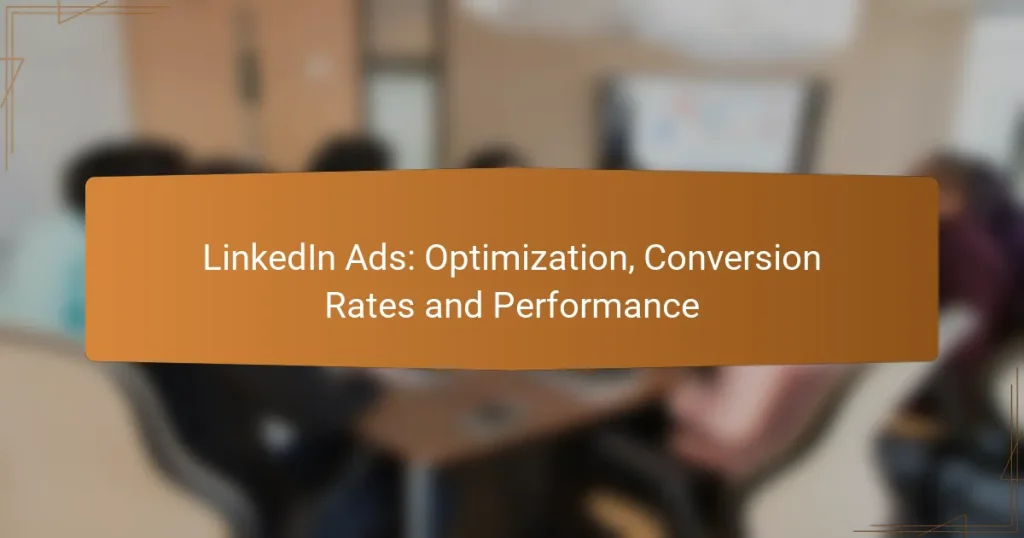LinkedIn provides a variety of advertising options designed to help businesses effectively connect with their target audience. From Sponsored Content to Video Ads, each format offers distinct features that cater to different marketing objectives. By understanding your audience and goals, you can choose the most suitable ad type to maximize your campaign’s impact.
LinkedIn Lead Gen Forms: Capture, Conversion and Efficiency
LinkedIn Ads: Optimization, Conversion Rates and Performance
What are the LinkedIn advertising options?
LinkedIn offers several advertising options tailored for businesses to reach their target audience effectively. These options include Sponsored Content, Text Ads, Sponsored InMail, Dynamic Ads, and Video Ads, each with unique features and benefits to consider.
Sponsored Content
Sponsored Content allows businesses to promote their posts directly in the LinkedIn feed, making them visible to a wider audience. This format is ideal for sharing articles, blog posts, or company updates, and can drive engagement through likes, shares, and comments.
To create effective Sponsored Content, focus on high-quality visuals and compelling copy. Consider using A/B testing to determine which content resonates best with your audience. Budgeting for Sponsored Content typically ranges from a few dollars to several hundred per day, depending on your targeting and goals.
Text Ads
Text Ads are simple yet effective advertisements that appear on the sidebar of LinkedIn pages. They consist of a short headline, a brief description, and an image, making them easy to create and manage.
When using Text Ads, keep your message concise and clear to capture attention quickly. This option is often budget-friendly, with costs based on a pay-per-click (PPC) or cost-per-impression (CPM) model, allowing for flexibility in spending.
Sponsored InMail
Sponsored InMail sends personalized messages directly to LinkedIn users’ inboxes, offering a more direct approach to engagement. This format is effective for lead generation, event invitations, or special promotions.
To maximize the impact of Sponsored InMail, ensure your message is relevant and provides value to the recipient. Monitor response rates closely, as this will help you refine your messaging strategy. Costs are typically based on a pay-per-send model, which can vary depending on your targeting criteria.
Dynamic Ads
Dynamic Ads are personalized advertisements that automatically adapt to each viewer, using their profile information to create a tailored experience. These ads can include follower ads, content ads, and spotlight ads, making them versatile for various marketing goals.
Utilize Dynamic Ads to enhance brand visibility and encourage user interaction. Ensure your visuals are eye-catching and your call-to-action is clear. Pricing for Dynamic Ads varies based on the chosen format and targeting options.
Video Ads
Video Ads on LinkedIn allow businesses to share engaging video content directly in users’ feeds. This format is particularly effective for storytelling, product demonstrations, and brand awareness campaigns.
When creating Video Ads, aim for high-quality production and a strong narrative to capture attention quickly. Keep videos short, ideally under 30 seconds, to maintain viewer interest. Costs can vary widely based on the length and quality of the video, as well as the targeting options selected.
How to choose the right LinkedIn advertising option?
Choosing the right LinkedIn advertising option depends on your target audience, campaign objectives, and budget. Assessing these factors will help you select the most effective ad format to achieve your marketing goals.
Target audience alignment
Understanding your target audience is crucial for effective LinkedIn advertising. Identify the demographics, job titles, industries, and interests of the professionals you want to reach. LinkedIn offers advanced targeting options, allowing you to tailor your ads to specific groups based on these criteria.
For example, if you are promoting a B2B service, targeting decision-makers in relevant industries can significantly improve engagement. Utilize LinkedIn’s audience insights to refine your targeting strategy and ensure your ads resonate with the right people.
Campaign objectives
Your campaign objectives will guide the type of LinkedIn ads you should use. Common goals include brand awareness, lead generation, website traffic, and event registrations. Each objective aligns with specific ad formats, such as Sponsored Content for awareness or Lead Gen Forms for capturing leads directly on the platform.
Clearly define your objectives before launching your campaign. This clarity will help you measure success and adjust your strategy as needed. For instance, if your goal is to increase website traffic, focus on ads that drive clicks rather than just impressions.
Budget considerations
Budget is a key factor in selecting LinkedIn advertising options. Determine how much you are willing to spend on your campaign and choose ad formats that fit within that budget. LinkedIn ads can range from a few dollars per click to higher amounts for premium placements.
Consider starting with a modest budget to test different ad formats and targeting strategies. Monitor performance metrics closely and adjust your spending based on what works best. Additionally, be aware of LinkedIn’s bidding options, such as cost-per-click (CPC) or cost-per-impression (CPM), to optimize your ad spend effectively.
What are the benefits of LinkedIn advertising?
LinkedIn advertising offers several advantages, including precise targeting of professionals, high engagement rates, and strong lead generation potential. These benefits make it an effective platform for B2B marketing and reaching decision-makers in various industries.
Professional targeting
LinkedIn allows advertisers to target users based on specific professional criteria such as job title, industry, company size, and location. This level of targeting ensures that your ads reach the most relevant audience, increasing the likelihood of engagement and conversions.
To maximize your targeting effectiveness, consider using LinkedIn’s Matched Audiences feature. This tool enables you to upload lists of contacts or retarget website visitors, ensuring your ads are shown to individuals who are already familiar with your brand.
High engagement rates
Ads on LinkedIn typically experience higher engagement rates compared to other social media platforms. This is largely due to the professional context of the platform, where users are more focused on business-related content.
To enhance engagement, create compelling ad copy and visuals that resonate with your target audience’s professional interests. Experiment with different formats, such as sponsored content, video ads, or carousel ads, to see which generates the best response.
Lead generation potential
LinkedIn advertising is particularly effective for lead generation, as it allows businesses to capture high-quality leads directly from their ads. Features like Lead Gen Forms enable users to submit their information without leaving the platform, streamlining the process.
When running lead generation campaigns, ensure your offer is attractive and relevant to your audience. Consider providing valuable resources, such as whitepapers or exclusive webinars, to encourage users to provide their contact information.
What are the costs associated with LinkedIn advertising?
The costs associated with LinkedIn advertising can vary significantly based on the chosen ad format, targeting options, and overall campaign objectives. Advertisers typically encounter costs related to clicks, impressions, and overall campaign budgets, which can help determine the effectiveness of their marketing efforts.
Cost per click (CPC)
Cost per click (CPC) refers to the amount advertisers pay each time a user clicks on their LinkedIn ad. This model is beneficial for campaigns focused on driving traffic to a website or landing page. CPC rates on LinkedIn generally range from a few dollars to over ten dollars, depending on factors like competition and targeting precision.
To optimize CPC, advertisers should focus on creating compelling ad copy and selecting relevant keywords. Regularly monitoring and adjusting bids can help maintain cost efficiency while maximizing click-through rates.
Cost per impression (CPM)
Cost per impression (CPM) is the cost incurred for every 1,000 times an ad is displayed on LinkedIn. This pricing model is ideal for brand awareness campaigns where visibility is more important than immediate clicks. CPM rates can vary widely, often starting around $6 to $10 per 1,000 impressions.
When using CPM, it’s crucial to target the right audience to ensure that the impressions lead to meaningful engagement. Advertisers should analyze performance metrics to assess whether their CPM campaigns are achieving desired visibility and engagement levels.
Average campaign budgets
Average campaign budgets for LinkedIn advertising can range from a few hundred to several thousand dollars, depending on the scale and goals of the campaign. Smaller businesses might start with a budget of around $500 to $1,000, while larger organizations may allocate tens of thousands for extensive campaigns.
Setting a clear budget is essential for managing costs effectively. Advertisers should consider their overall marketing strategy and expected return on investment when determining their LinkedIn advertising budget. Regularly reviewing campaign performance can help in reallocating funds to the most effective ads and strategies.
How to measure the success of LinkedIn ads?
Measuring the success of LinkedIn ads involves tracking key performance indicators (KPIs) that reflect your advertising goals. Focus on metrics like conversion rates, engagement levels, and return on ad spend (ROAS) to assess effectiveness and optimize future campaigns.
Conversion tracking
Conversion tracking allows you to monitor specific actions users take after interacting with your ads, such as signing up for a newsletter or making a purchase. To set this up, use LinkedIn’s Insight Tag, which is a piece of JavaScript code you place on your website to track conversions accurately.
Consider defining what constitutes a conversion for your business, whether it’s a lead, sale, or other valuable action. Regularly review your conversion data to identify trends and adjust your ad strategies accordingly.
Engagement metrics
Engagement metrics measure how users interact with your ads, including clicks, likes, shares, and comments. High engagement rates often indicate that your content resonates with your audience, which can lead to increased brand awareness.
To evaluate engagement, track metrics such as click-through rates (CTR) and interaction rates. Aim for a CTR of around 0.5% to 1% as a benchmark, but adjust your expectations based on your industry and campaign goals.
Return on ad spend (ROAS)
Return on ad spend (ROAS) calculates the revenue generated for every dollar spent on advertising. A higher ROAS indicates a more effective ad campaign, making it a crucial metric for evaluating overall success.
To calculate ROAS, divide the total revenue generated from your ads by the total ad spend. A common target is to achieve a ROAS of at least 4:1, meaning for every $1 spent, you earn $4 in revenue. Regularly analyze this metric to ensure your advertising efforts are profitable.
What are best practices for LinkedIn advertising?
Best practices for LinkedIn advertising focus on targeting the right audience, crafting compelling ad copy, and optimizing campaigns for performance. By understanding your audience and continuously refining your approach, you can enhance engagement and drive better results.
Ad copy optimization
Ad copy optimization involves creating clear, concise, and persuasive messages that resonate with your target audience. Focus on highlighting the unique value proposition of your product or service, and use language that speaks directly to the needs and interests of your audience.
Consider using strong calls to action (CTAs) that encourage users to take the next step, whether it’s visiting your website or signing up for a newsletter. A/B testing different versions of your ad copy can help identify which messages perform best, allowing you to refine your approach based on real data.
Keep in mind that LinkedIn users are often professionals looking for solutions to their challenges. Therefore, using industry-specific terminology and addressing pain points can significantly improve the effectiveness of your ad copy. Aim for a tone that is both professional and approachable to foster trust and engagement.


